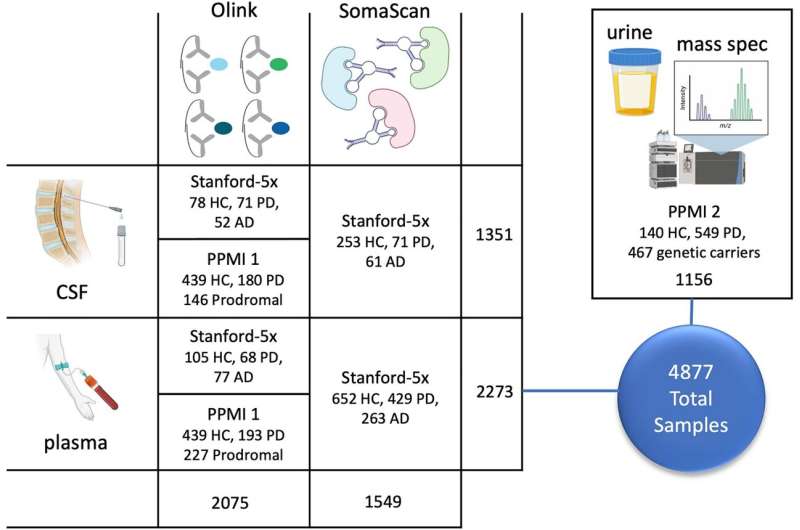This article has been reviewed according to Science X's editorial process and policies. Editors have highlighted the following attributes while ensuring the content's credibility:
fact-checked
trusted source
proofread
Alzheimer's and Parkinson's biomarkers show promise for early diagnosis

New research supported by the Knight Initiative for Brain Resilience at Stanford's Wu Tsai Neurosciences Institute highlights significant strides researchers have made in developing biomarkers for the early detection and monitoring of neurodegenerative diseases—including Alzheimer's disease (AD), Parkinson's disease (PD) and Lewy body disease (LBD).
The two studies, both overseen by Knight Initiative steering committee member Kathleen Poston, the Edward F. and Irene Thiele Pimley Professor of Neurology, alongside numerous Stanford collaborators, show cause for optimism in efforts to precisely identify these disorders at their earliest stages, improving chances of effectively treating or one day reversing the conditions.
Identifying new Parkinson's biomarkers
In one study, published March 11, 2024, in Acta Neuropathologica, a research team led by graduate student Jarod Rutledge in the lab of Tony Wyss Coray, the DH Chen Professor of Neurology and director of the Knight Initiative, focused on identifying new biomarkers for early diagnosis and disease monitoring in Parkinson's disease (PD).
The researchers analyzed thousands of samples of cerebrospinal fluid, blood plasma, and urine from participants across five Stanford cohorts and two external cohorts. Using multiple proteomic methods, they discovered hundreds of proteins that were enriched at higher levels in PD patients as well as in asymptomatic individuals with genetic risk factors for developing PD.
Among the identified proteins, DOPA decarboxylase (DDC) stood out due to its consistent upregulation in the cerebrospinal fluid and urine of participants with PD or related risk genes—as well as its link to the dopamine-producing neurons whose degeneration is central to the disease.
The team found that levels of DDC in participant cerebrospinal fluid correlate with clinical symptom severity in patients and that the biomarker could be used on its own to accurately diagnose the disorder.
The findings suggest that DDC could be a promising diagnostic and prognostic marker for PD, with potential utility in both clinical care and translational research. Not only could early biomarkers for PD potentially improve patient outcomes through early detection and treatment, but it could also provide a valuable readout of disease progression in clinical trials of experimental drugs.
Shared pathology in Alzheimer's and Lewy body disease
The second study, led by postdoctoral scholar Melanie Plastini in the Poston lab and published March 4, 2024, in the Annals of Clinical and Translational Neurology, investigated recently developed biomarkers for Alzheimer's disease (AD) and Lewy body disease (LBD) (which includes both Parkinson's disease and dementia with Lewy Bodies), and compared these early indicators with traditional methods of diagnosing these neurodegenerative conditions.
The study was motivated by the fact that these diseases often share symptoms and can be hard to tell apart with traditional behavior-focused approaches.
The researchers focused on recently-developed assays for detecting LBD and AD in samples of cerebrospinal fluid (the fluid surrounding the brain and spinal cord). One, the transformative new "α-synuclein seed amplification assay" (αSyn-SAA), detects signs of α-synuclein, a protein clumps together inside brain cells to form Lewy bodies in people with LBD. Similarly, CSF biomarkers for amyloidosis and Alzheimer's disease neuropathological change (ADNC) can indicate the presence of Alzheimer's disease and other conditions.
The study discovered that the αSyn-SAA test is particularly good at identifying patients who have LBD, even better than traditional methods. It can also predict if a different neurological diagnosis might change to LBD in the future, which is helpful for early treatment and support.
Additionally, the researchers found that many patients with LBD also show signs of Alzheimer's disease, especially as cognitive symptoms like memory loss and confusion worsen. This overlap suggests that both diseases can exist together, making diagnosis and treatment more complex, but highlighting the value of using multiple biomarkers to better distinguish these cases.
A new era for neurodegenerative disease biomarkers
Taken together the new findings from Poston and colleagues at the Knight Initiative highlight the remarkable potential of our growing armamentarium of in vivo biomarkers to improve the early detection and monitoring of neurodegenerative diseases.
The discovery of DDC as a promising biomarker for PD could lead to earlier diagnosis and more effective treatment strategies. Similarly, the combination of LBD and AD biomarkers could help identify people with either or both disorders better and earlier than traditional clinical diagnostic criteria alone.
These findings could have significant implications for improving patient care and informing the design of clinical trials in neurodegenerative diseases.
"Both of these studies highlight an important shift in how we think about and understand Parkinson's disease and dementia with Lewy bodies," said Poston.
"Until now, these were primarily studied through the lens of clinical symptoms with very little understanding of the disease biology until we had an autopsy. These new biofluid based markers allow us to study important biological changes in living patients, which is an important step toward developing disease-targeted and personalized therapies."
More information: Jarod Rutledge et al, Comprehensive proteomics of CSF, plasma, and urine identify DDC and other biomarkers of early Parkinson's disease, Acta Neuropathologica (2024). DOI: 10.1007/s00401-024-02706-0
Melanie J. Plastini et al, Multiple biomarkers improve diagnostic accuracy across Lewy body and Alzheimer's disease spectra, Annals of Clinical and Translational Neurology (2024). DOI: 10.1002/acn3.52034





















